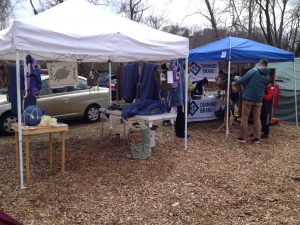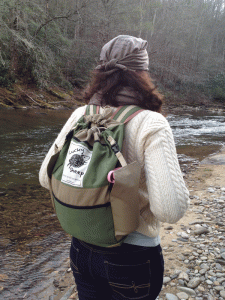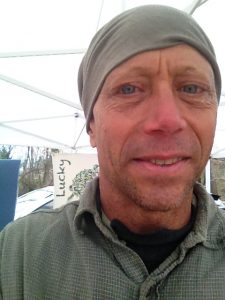 This weekend I showed Lucky Sheep Sleeping Bags at the Outdoor Gear Builders of Western North Carolina’s annual Get in Gear Fest. This was a collaboration of diverse outdoor gear builders showing their wares. It was 38 Degrees and sometimes drizzly and that was actually perfect for our gear because it shows how important it is to have good gear. And my wool sleeping bags are particularly hydrophilic and so it made Lucky Sheep look even more attractive. Most people would consider this too cold for a successful festival and indeed, it was much less attended than last year which had warmer sunnier weather. However it points out the cold hard truth that outdoor adventure means putting oneself against the elements. And to me it seemed perfect in an odd way.
This weekend I showed Lucky Sheep Sleeping Bags at the Outdoor Gear Builders of Western North Carolina’s annual Get in Gear Fest. This was a collaboration of diverse outdoor gear builders showing their wares. It was 38 Degrees and sometimes drizzly and that was actually perfect for our gear because it shows how important it is to have good gear. And my wool sleeping bags are particularly hydrophilic and so it made Lucky Sheep look even more attractive. Most people would consider this too cold for a successful festival and indeed, it was much less attended than last year which had warmer sunnier weather. However it points out the cold hard truth that outdoor adventure means putting oneself against the elements. And to me it seemed perfect in an odd way.
I have spent my life researching and inventing around minimalism and body friendly design and wellness and I got to show off some of my favorite creations. There were a lot of conversations around sleeping bag choices 1) Down 2) Synthetic 3) Wool. Instead of just the two factors of weight and temperature rating–I point out that SLEEP QUALITY is left out of the conversation and that is my goal for Lucky Sheep to set a new standard for sleeping bags. Many people don’t go camping because they see it as uncomfortable and I believe that is in a big way due to synthetic materials which hamper sleep quality by messing with heart rate, brain waves, body temp regulation and rob electrons from the cells and cause the feeling of claminess (condensation).

Forest Bathing is a therapeutic approach to spending time in nature and is not focused on a goal of hiking as many miles or bagging as many peaks as possible. The goal of forest bathing is to see the Forest as the Cathedral and absorb the negative ions from the mist, watch the stars, soak in the sun and immerse in pristine pools. I call my system Natural Camping. The goal is not about survival and pushing limits to the edge, but rather to see how the forest can revive health, well being and peace of mind.
I could defend the value of wool as far as high performance outdoor gear that gives your biology an edge by increasing your sleep quality so you hike further and faster. However I am not interested so much in that as I am in heightening the feeling of fun and vitality.
I felt right in my element and noticed a lot of people shriveling up against the cold. Observing the whole perception around cold and noticing clothing/gear and people shivering and doing things which were`counter productive to staying warm. My own approach i consider the BODY as the first GEAR and how to use BIOLOGY and BIOHACKING to make the body work in the elements.
I was wearing a thin merino wool sweater under a cotton shirt, merino base layer under blue jeans, and a merino bandana on my head. To me it felt like the perfect temperature when some people wear dressed quite thickly with the latest down/synthetic parkas and were cold. Not to criticize or ruin anyone’s picnic but putting info out there to help us all feel more alive and connect with nature and not be afraid of the cold. (Note: this was city clothing and I would have something different for hiking and camping which I will demonstrate in another post).

Other gear builders approaching it from a technological place where the gadgets do the work instead and not understanding how plastic and synthetics hamper the body’s ability to deal with the cold. What I mean by this is the typical camper seems to be afraid of nature zipping themselves up in a plastic tent away from the fresh air and inside a synthetic sleeping bag and clothing which bring the energy of the body down in several ways. Most ‘Peak Baggers’ are thinking about how much weight they are carrying on their back and plastic is convenient. However what most people don’t know, plastic tents hold the humidity from the body (insensible perspiration) and this humidity creates a colder experience.
Here is my approach to spending a day outdoors on a cold day:
1) Prepare yourself like I do and become cold adapted by living close to the cold and doing Cold Water Immersions. In other words, don’t overheat your living space. The body adapts and accommodates us far more than we realize. Use the outdoor experience to further your cold adapting abilities by wearing the LEAST amount of clothing that you need. This means dressing in layers and wearing a daypack with extra room. Don’t be afraid to stop and add or subtract clothing items when needed. The Lucky Sheep™ Chi Pack is a perfect choice for this.
2) Following a ketogenic diet meaning I get most of my calories from fat instead of carbohydrates. Start the day off with high fat, moderate protein meal and use snacks of pemmican and butter balls. See my article Heat Generating Foods that Make You Glow Inside.
3) Not drinking alcohol because it is ruins step two.
4) Wearing wool clothing as inside layer and lightweight tight-weave cotton on outside layer (as wind barrier).
5) Don’t sit down but stand instead which is Activity Thermogenesis and generates some body heat.
6) Drinking hot beverages with melted butter and coconut oil.
7) Avoid a hot shower in morning because that would open skin pores and make you cold later and don’t take a cold shower because it would lower your body temp. with no way to raise it back up. Rather, use the cold air all day long exposure as cold therapy.
8) Cover the head where a lot of of heat escapes from the body and it is important to keep the brain warm.
9) Rain and Wind Protective Clothing Natural Options
As I was becoming aware of the physics of all this and testing alternatives, one of the last plastic items in my camping gear was a Gore Tex parka and I started noticing how I would overheat easily in certain conditions. I would be unbearably hot and stuffy with it on and yet with it off I would get wet and be too cold. This overheating would cause sweating and ultimately I would often be too hot at times and later would chill because of the sweat. This same phenomenon happens when sleeping zipped up in a plastic tent and with synthetic fabric sleeping bags. I started using an oversized tight weave cotton shirt as a wind breaker and in most conditions I was far more comfortable. For actual rain protection I used a plastic poncho which allows more air circulation and would come off when the rain let up but keep the cotton wind breaker on.
10) For my tent I started using an amazing tarp system that weighs two pounds, fits two people and gear, and is similar to using an umbrella. I was completely protected by most rains and yet had ample ventilation. This gear options completely changed my game. The reason was because my skin could breath, my body could regulate temperature, and I could be breathing the fresh air which is why I came out there in the first place. Click here for a short demo of the Ray Way Tarp System.
